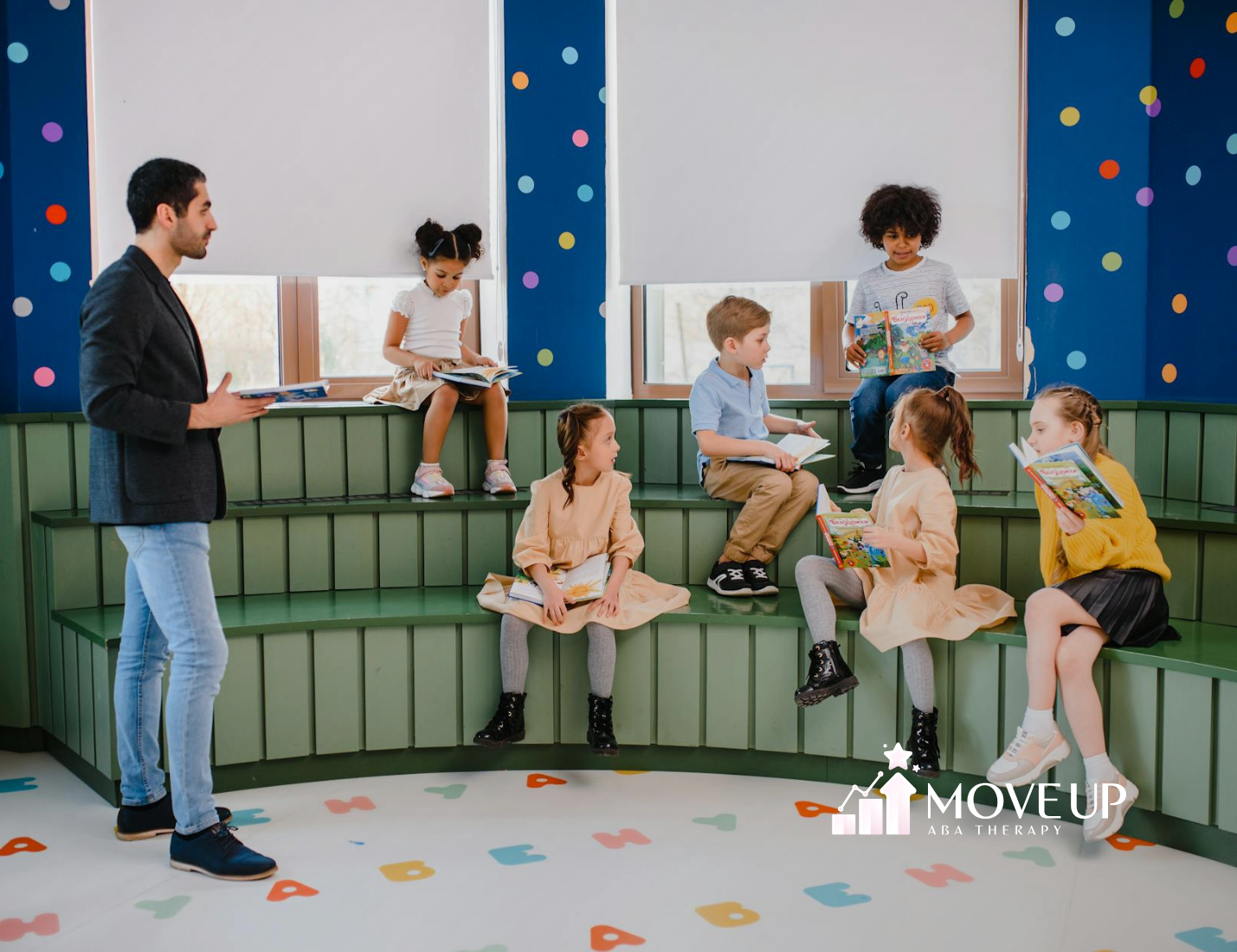Hey there, awesome parents and caregivers! Ready to dive into the world of ABA therapy goals? Buckle up, because we’re about to embark on an exciting journey that could change your child’s life for the better. Whether you’re new to Applied Behavior Analysis therapy or you’re looking to supercharge your kiddo’s progress, we’ve got you covered. Let’s explore how setting the right goals can help your child with autism spectrum disorder (ASD) reach for the stars!
What’s the Big Deal About ABA Therapy Goals?
First things first – why are we making such a fuss about goals? Well, imagine trying to drive to a new place without a GPS or map. Pretty tricky, right? That’s what ABA therapy would be like without clear, meaningful goals. They’re our roadmap to success, guiding every step of the journey.
ABA therapy aims to create meaningful behavior change and achieve positive outcomes in your child’s life. It’s not just about managing challenging behaviors (though that’s part of it!). It’s about equipping your kiddo with the skills they need to thrive in everyday life. From mastering the art of tying shoelaces to navigating complex social situations, ABA therapy goals cover it all!
Success Stories
“Move Up ABA has been a lifeline for our family. Before starting therapy, our son struggled with daily routines and communication. Now, he’s more independent and even initiated a conversation with a classmate for the first time! The progress we’ve seen in just six months is truly remarkable.”
- Emily R., Silver Spring, Accountant
“As a single dad, I was overwhelmed trying to manage my child’s behavior. The Move Up ABA team not only provided amazing support for my little girl but also taught me practical strategies to use at home. Their in-home sessions fit perfectly with our busy schedule. I’m so grateful for their patience and expertise.”
- Michael T., Rockville, Middle School Teacher
“We were hesitant about starting ABA therapy, but Move Up ABA’s approach put us at ease from day one. Our twins have made incredible strides in their social skills and self-regulation. The therapists are like extended family now, and we couldn’t be happier with our decision to work with them.”
- Aisha and James L., Simpson, Police Officers
The ABCs of Setting ABA Therapy Goals
So, how do we go about setting these all-important goals? It’s not as simple as waving a magic wand (though wouldn’t that be nice?). It takes a collaborative effort between you, your child, and the therapy team. Here’s the secret sauce:
1. Assess Your Child’s Current Skills:
Before we can plan the journey, we need to know where we’re starting from. A Board Certified Behavior Analyst (BCBA) will conduct a thorough assessment of your child’s current abilities. It’s like taking a snapshot of your child’s skills across different areas.
2. Identify Areas for Improvement:

Based on this assessment and your input (because hey, you’re the expert on your child!), the BCBA will identify areas where your child could use a little extra help. Maybe it’s working on communication skills, or perhaps it’s fine-tuning those social interactions.
3. Set Clear and Measurable Goals:
Here’s where the magic happens! The BCBA will work with you to set specific, measurable goals. We’re not talking vague wishes here – we want concrete, achievable targets. For example, instead of “improve communication,” we might aim for “use three-word sentences to make requests.”
4. Break It Down:
Rome wasn’t built in a day, and neither are new skills. The therapy team will break down each goal into smaller, manageable steps. It’s like creating a staircase to success – one step at a time!
5. Track Progress:
ABA therapy is all about data. We’ll be collecting information on your child’s progress like squirrels collect acorns! This ongoing assessment helps us see what’s working and what might need tweaking.
Types of ABA Therapy Goals: A Buffet of Possibilities
ABA therapy goals are as diverse as our kiddos themselves. Here’s a taste of what we might focus on:
1. Communication Skills: Finding Their Voice
For many children with ASD, communication can be a bit of a puzzle. ABA therapy goals in this area might include:
Developing receptive language skills (understanding what others are saying)
Enhancing expressive language (getting their thoughts across)
Mastering nonverbal communication cues
Exploring alternative communication methods for our non-verbal superstars
Imagine the joy of hearing your child say “I love you” for the first time, or seeing them use a communication device to express their needs. That’s the power of communication goals!
2. Social Skills: Navigating the Friendship Maze
Social interactions can sometimes feel like a complex dance for kids with ASD. Here’s where ABA therapy can work its magic:
Learning appropriate social greetings
Understanding and respecting personal space
Developing turn-taking skills
Improving conversational skills
Picture your child confidently joining a group game at the park or having a back-and-forth conversation with a friend. These social goals can open up a whole new world!
3. Daily Living Skills: Boosting Independence
Who doesn’t want to see their child become more independent? ABA therapy goals in this area might include:
Mastering personal hygiene routines
Learning to dress independently
Developing food preparation skills
Managing homework and school responsibilities
Imagine the pride on your child’s face when they tie their shoes for the first time or make their own sandwich. These self-help skills are game-changers!
4. Behavior Management: Turning Challenging Behavior to Positive ones
Let’s face it – challenging behaviors can be tough for everyone involved. ABA therapy can help by:
Identifying triggers for problem behaviors
Teaching alternative, positive behaviors
Developing self-regulation strategies
Increasing tolerance for changes in routine
Picture a peaceful bedtime routine or a tantrum-free grocery store trip. With the right behavior management goals, these can become your new normal!
5. Academic Skills: Setting the Stage for Learning

For many of our kiddos, school can be a bit overwhelming.
ABA therapy goals can help by:
Improving focus and attention span
Developing organizational skills
Enhancing reading comprehension
Boosting math skills
Imagine your child confidently tackling their homework or raising their hand in class. These academic goals can set the stage for a lifetime of learning!
The Secret Ingredient: Positive Reinforcement
Now, here’s where the real magic happens. In ABA therapy, we’re all about catching kids being awesome and celebrating their wins. This positive reinforcement is like fuel for progress. Did your child use a new word? Time for a mini dance party! Did they share a toy with a sibling? Break out the high fives!
By consistently reinforcing desired behaviors, we’re not just achieving our therapy goals – we’re making the whole process fun and rewarding for your child. It’s like sprinkling fairy dust on our efforts!
How Many Hours of ABA Therapy? Finding the Right Dose
One question we often hear is, “How many hours of ABA therapy does my child need?” Well, it’s not quite as simple as following a recipe. The number of therapy hours can vary based on your child’s individual needs, the intensity of the goals, and your family’s schedule.
Some children might benefit from 10-15 hours a week, while others might need 20-40 hours. The key is to work with your BCBA to find the right balance. Remember, quality trumps quantity every time!
Teamwork Makes the Dream Work: Your Role in ABA Therapy
Here’s a little secret: you’re not just a spectator in this process – you’re a key player! The most successful ABA therapy happens when therapists work closely with parents and caregivers. After all, you’re with your child way more than we are!
Your BCBA will work with you to develop strategies you can use at home to reinforce skills and facilitate progress. It’s like you’re becoming a mini-therapist yourself (how’s that for a super-power?).
The Journey Never Ends: Ongoing Assessment and Goal Adjustment
Here’s the thing about ABA therapy goals – they’re not set in stone. As your child grows and develops, their needs and abilities will change. That’s why ongoing assessment is such a fundamental aspect of ABA therapy.
Your therapy team will regularly review your child’s progress, identify new patterns, and adjust goals as needed. It’s like having a GPS that recalculates the route as you go, always ensuring you’re on the best path to success.
The Science Behind the Magic: Behavioral Principles in ABA
Ever wonder how ABA therapy works its magic? It’s all based on solid behavioral principles. These scientific concepts help us understand how behaviors are learned and how we can modify them. Here’s a peek behind the curtain:
Reinforcement: This is all about increasing desired behaviors. When we reward a behavior, it’s more likely to happen again.
Shaping: We use this to teach complex skills by reinforcing small steps towards the goal.
Prompting: Sometimes, our kiddos need a little nudge in the right direction. Prompts help guide them towards the desired behavior.
Fading: As skills improve, we gradually reduce prompts to promote independence.
Understanding these principles helps us develop targeted interventions that really work!
Individualized Treatment Plans: Because One Size Doesn’t Fit All

In ABA therapy, we don’t believe in cookie-cutter approaches. Each child is unique, so their treatment plan should be too! Our BCBAs work hard to create individualized treatment plans that:
Address your child’s specific needs and challenges
Build on their strengths and interests
Fit with your family’s lifestyle and values
Focus on skills that will have the biggest impact on your child’s quality of life
It’s like having a custom-tailored suit for your child’s development!
Measuring Success: The Power of Data Collection
In ABA therapy, we’re not just guessing whether things are working – we know! That’s because data collection is a huge part of what we do. Here’s why it’s so important:
It helps us track progress objectively
We can quickly identify what’s working and what’s not
It allows us to make data-driven decisions about adjusting goals or strategies
It provides concrete evidence of your child’s improvements
Think of it like a report card that comes out every day instead of every semester!
Beyond the Therapy Room: Generalizing Skills to Everyday Life
ABA therapy isn’t just about what happens in therapy sessions. The real goal is to help your child use their new skills in everyday life. This process is called generalization, and it’s super important! Here’s how we make it happen:
Practice skills in different settings (at home, at school, in the community)
Work with different people (therapists, family members, teachers)
Use various materials and situations
It’s like taking the training wheels off – we want your child to ride freely in the real world!
The ABA Therapy Focus: A Holistic Approach
While ABA therapy often focuses on specific behaviors or skills, the ultimate aim is to improve your child’s overall quality of life. We’re not just looking at isolated behaviors – we’re considering how everything fits together to help your child thrive. This holistic approach means:
Considering how different skills interact (like how better communication can lead to fewer challenging behaviors)
Looking at your child’s functioning across different environments (home, school, community)
Addressing not just visible behaviors, but also the underlying skills that support them
It’s like putting together a puzzle – each piece is important, but the real magic happens when we see the whole picture!
Early Intervention: The Early Bird Gets the Worm
One last thing before we wrap up – let’s talk about the importance of early intervention. The sooner we start working on these goals, the better the outcomes tend to be. It’s like planting a seed – the earlier you plant it, the stronger the tree will grow!
If you suspect your child might benefit from ABA therapy, don’t wait. Reach out to a certified behavior analyst (BCBA) and start the conversation. Remember, you’re not alone in this journey!
Wrapping It Up: Your Child’s Potential is Limitless with Move Up ABA!

There you have it, folks! A whirlwind tour of ABA therapy goals and how they can help unlock your child’s potential. Remember, every child is unique, and progress might look different for each kiddo. The key is to celebrate every step forward, no matter how small it might seem.
At Move Up ABA, we’re not just passionate about helping children with ASD thrive – we’re dedicated to moving your child up to their fullest potential! Our team of expert ABA therapists in Maryland is ready to work closely with you to create an individualized treatment plan that fits your child’s unique needs and your family’s lifestyle.
What sets Move Up ABA apart? We believe in:
Tailored, evidence-based interventions
A fun, nurturing approach that keeps your child engaged
Close collaboration with parents and caregivers
Continuous assessment and goal adjustment
Generalization of skills across all areas of your child’s life
Ready to start this incredible journey with Move Up ABA? Let’s set some goals and watch your child soar! Our caring team is just a phone call or email away, ready to answer your questions and guide you through the process.
Remember, with the right support from Move Up ABA and a sprinkle of ABA magic, the sky’s the limit for your little superstar. Together, we’ll help your child move up and reach heights you never thought possible!
Contact Move Up ABA today, and let’s take the first step towards unlocking your child’s amazing potential. Your child’s brighter future starts here!
400 E Pratt St, Floor 8 Baltimore , Maryland 21202, United States
Questions?
Email Us: intake@moveupaba.com
Call Us: (410) 469-1090






